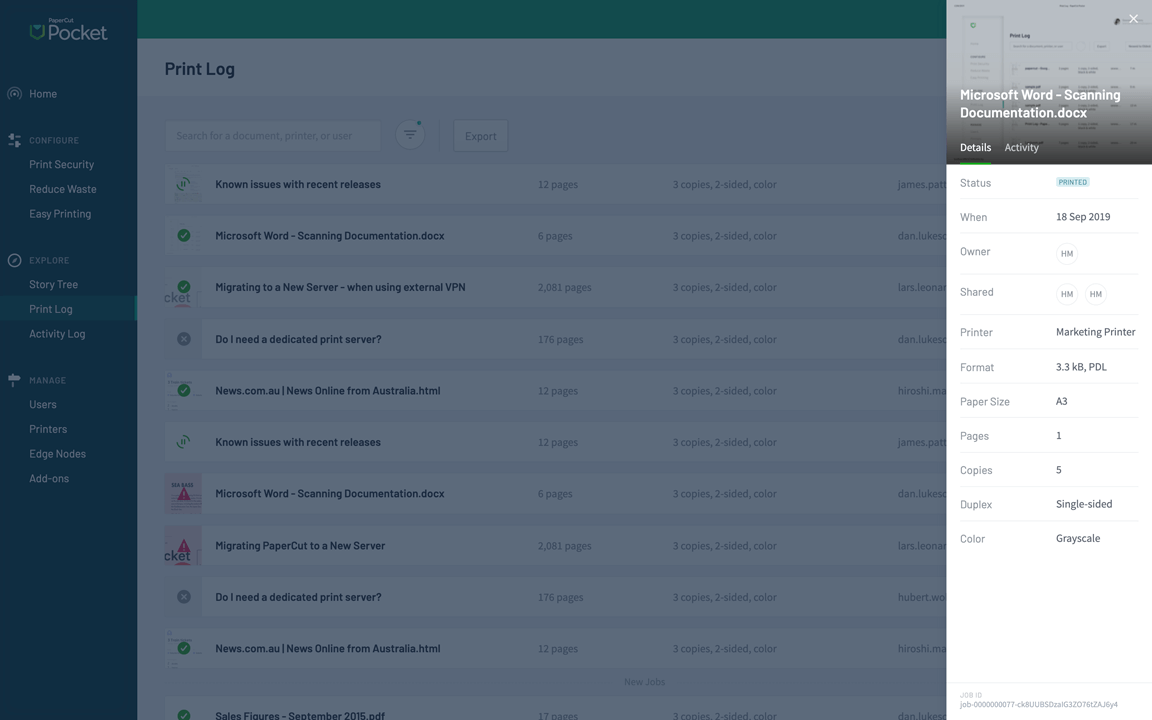Many businesses don’t have a clear picture of how much printing is costing them.
They might have a vague idea of how many printers they have, how often they need to replace toner and paper, and how many print-related issues they deal with on a daily basis.
But what about how many pages are printed by each user, department, or device?
How much printing is wasteful, unnecessary, or insecure? How do you optimize printing to save money, reduce environmental impact, and improve productivity?
If you don’t know the answers to any of those questions either, then you need print auditing. Print auditing is the process of collecting and analyzing data about your print activity.
It’s the first step to print management – the practice of controlling and optimizing your print environment.
Print management can help you achieve significant benefits, such as:
- Reducing your print costs by up to 30%
- Enhancing your document security and compliance
- Minimizing your carbon footprint and paper waste
- Improving your user experience and satisfaction
- Streamlining your IT operations and support
Before you can reap these rewards, you need to know where you stand by auditing your print activity and identifying areas where you can improve. Specifically you want to read up on print job logging, print reporting, and print archiving.
Print job logging: real-time tracking
Print job logging is the foundation of print auditing. It’s the process of capturing information about every print job that occurs on your network. This information can include:
- The user who initiated the print job
- The device that processed the print job
- The document name and type
- The number of pages and copies
- The color mode and duplex mode
- The date and time of the print job
- The status and outcome of the print job
Print job logging can be done in different ways, depending on your print infrastructure and software. Some printers have built-in logging capabilities that can store data on their internal memory or send it to a central server.
However, this method may not capture all the details you need, or it may not be compatible with all your devices.
A more reliable and comprehensive way to log print jobs is to use dedicated print management software that can monitor all your printers from a single point.
Print management software can also provide additional features that enhance your print auditing capabilities, such as:
User authentication and authorization
You can require users to enter their credentials or swipe their ID cards before they can access printers or release their print jobs.
This way, you can ensure that only authorized users can print, and that every print job is accurately attributed to its owner.
read morePrint policies and rules
You can set up rules that automatically enforce your print policies, such as limiting color printing, enforcing duplex printing, or redirecting large jobs to more efficient devices. This way, you can reduce unnecessary printing and save on resources.
read morePrint quotas and charging
You can assign quotas or budgets to users, departments, or projects, and track their usage over time. You can also charge users for their printing based on predefined rates or cost centers.
This way, you can recover your printing expenses and encourage responsible printing behavior.
read morePrint reporting: print behavior statistics
Print reporting is the next step in print auditing. It’s the process of analyzing the data collected by print job logging and presenting it in a meaningful way. Print reporting can help you answer questions such as:
- How much are you spending on printing?
- Who are your top users or departments in terms of print volume or cost?
- Which are your most used or underused devices?
- What are the trends and patterns in your print activity over time?
- How effective are your print policies and rules?
- How much are you saving or wasting on printing?
Print reporting can be done manually by exporting the data from your printers or software and creating spreadsheets or charts, but this method can be time-consuming, error-prone, and outdated.
A better way to generate print reports is to use print management software that can automate the process and provide dynamic and interactive dashboards.
Print management software can also provide additional features that enhance your print reporting capabilities, such as:
Customizable reports
You can create reports that suit your specific needs and preferences, such as choosing the data fields, filters, formats, and layouts.
You can also schedule reports to run automatically and send them to your email or other destinations, or even share reports with other stakeholders and export them to various formats.
read moreInteractive dashboards
You can access real-time data and insights on your print activity through a web browser. You can also drill down into the details, filter by various criteria, and compare different metrics and periods.
Environmental reports
You can measure the environmental impact of your printing, such as the amount of paper, energy, and greenhouse gas emissions saved or consumed. You can also set environmental goals and track your progress towards them.
read more
Print archiving: document records
Print archiving is the final step in print auditing. It’s the process of storing and retrieving the content of printed documents. Print archiving can help you with:
Compliance and governance:
You can meet the legal or regulatory requirements that mandate you to keep a record of all printed content. You can also protect your intellectual property and sensitive information from unauthorized access or leakage.
Misuse and abuse detection:
You can monitor not only the volume but also the content of printed documents. You can identify and prevent inappropriate or illegal printing, such as printing personal photos, confidential documents, or offensive material.
Document retrieval and reprinting:
You can access past print jobs and view them in a web browser. You can also download the original spool files and reprint them with 100% fidelity.
Print archiving can be done by enabling the “keep printed documents” feature on your printers or software although this method may not be secure, convenient, or scalable.
A better way to archive print jobs is to use print management software to automate the process and provide a user-friendly interface.
Print management software can also provide additional features that enhance your print archiving capabilities, such as:
Image capture technologies:
You can capture the images of printed documents via a spool file recorder and store them on a central server. You can also compress and encrypt the images to save space and ensure security.
Fine-grained access control:
You can decide who can access the archived print jobs and what they can do with them. You can also require users to authenticate before they can view or reprint their own print jobs.
Content search and filter:
You can easily find the print jobs you need by searching or filtering by various criteria, such as user, printer, date, time, document name, or the number of pages.
Visibility and control of your print environment
Print auditing is an essential part of print management. It helps you gain visibility and control over your print environment and achieve significant benefits in terms of cost savings, security, sustainability, productivity, and user satisfaction.
To perform print auditing effectively, you need three key components: print job logging, print reporting, and print archiving.
These components can be implemented with different methods, but the best way to do it is to use print management software that can provide you with comprehensive and powerful features.
If you’re looking for print management software that can help you with print auditing and more, look no further than PaperCut .
We’re a leading solution that has been trusted by over 139 million users in more than 195 countries.
PaperCut offers a range of products that suit different needs and budgets, from small businesses to large enterprises, from education to healthcare. PaperCut also supports all platforms, devices, printers, and languages.







